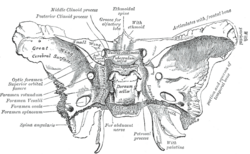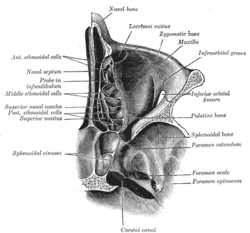[GROUP 1: Structure]
- The foramen ovale is an opening in the greater wing of the sphenoid bone.
- It is one of two cranial foramina in the greater wing, along with the foramen spinosum.
- The foramen ovale is located posterolateral to the foramen rotundum and anteromedial to the foramen spinosum.
- It is posterior and medial to the opening for the carotid canal.
- The foramen ovale serves as a passage for various structures, including the mandibular nerve, accessory meningeal artery, lesser petrosal nerve, emissary vein, and occasionally the meningeal branch of the mandibular nerve.
[GROUP 2: Contents]
- The mandibular nerve, a branch of the trigeminal nerve, passes through the foramen ovale.
- The accessory meningeal artery also passes through this opening.
- The lesser petrosal nerve, a branch of the glossopharyngeal nerve, traverses the foramen ovale.
- An emissary vein connects the cavernous sinus with the pterygoid plexus through this foramen.
- Sometimes, the meningeal branch of the mandibular nerve can also be found passing through the foramen ovale.
[GROUP 3: Variation]
- In a study conducted on 100 skulls, it was found that the foramen ovale was divided into 2 or 3 components in 4.5% of the cases.
- Some skulls showed irregular and rough borders of the foramen, suggesting possible morbid changes based on radiological images.
- The length of the foramen ovale is about 3.85 mm in newborns and 7.2 mm in adults.
- The average maximal length in adults is about 7.48 mm, while the average minimal length is 4.17 mm.
- The width of the foramen ranges from 1.81 mm in newborns to 3.7 mm in adults.
[GROUP 4: Development]
- The shape and size of the foramen ovale change throughout life, similar to other foramina.
- In a study using over 350 skulls, the earliest formation of a perfect ring-shaped foramen ovale was observed in the 7th month of fetal life.
- The latest formation of this shape was observed in individuals up to 3 years old.
[GROUP 5: Clinical significance]
- The foramen ovale is used as an entry point into the skull for Percutaneous Rhizotomy procedures to treat trigeminal neuralgia.
- It is also used to surgically place local electrodes on the surface of the mesial temporal lobe to observe neural activity in patients with suspected focal epilepsy.
- The name 'foramen ovale' comes from the Latin words for 'oval hole' or 'window.'
- This anatomical structure has been described in Gray's Anatomy, a widely used reference book.
- Various research studies have been conducted to investigate the morphology, morphometry, and anatomical variations of the foramen ovale.
The foramen ovale (Latin: oval window) is a hole in the posterior part of the sphenoid bone, posterolateral to the foramen rotundum. It is one of the larger of the several holes (the foramina) in the skull. It transmits the mandibular nerve, a branch of the trigeminal nerve.
| Foramen ovale of sphenoid bone | |
|---|---|
 Sphenoid bone. Upper surface. (foramen ovale labeled at left, third from bottom) | |
 Horizontal section of nasal and orbital cavities. | |
| Details | |
| Part of | sphenoid bone |
| System | skeletal |
| Identifiers | |
| Latin | foramen ovale ossis sphenoidalis |
| TA98 | A02.1.05.036 |
| TA2 | 622 |
| FMA | 53155 |
| Anatomical terms of bone | |